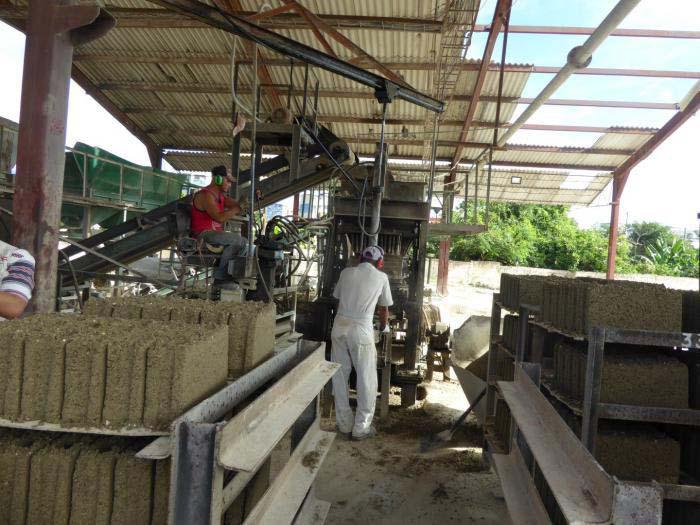
Design and professional technical services for the housing sector and its urbanizations, the construction materials and products industry, and the local materials production program, feature among the current priorities of the Ministry of Construction (Micons).
Debates focused on these areas during the evaluation of the objectives met and the shortcomings in the sector in 2017, which was attended by the member of the Party Political Bureau and Vice President of the Councils of State and Ministers, Comandante of the Revolution Ramiro Valdés Menéndez, and the Minister of Construction, René Mesa Villafaña.
According to Francisco Díaz Hernández, president of the Construction Materials Enterprise Group, 2017 was a tense year. Although there are results to show regarding the production of materials, the planned levels of cement production were not met.
This shortcoming is due to the poor technical condition of concrete plants and the lack of financial resources to acquire the planned materials, parts, pieces and equipment.
“In the 2018 plan, the export of cement is not envisaged, but we have put a lot of effort into the quality of the materials, so that the production is more effective and economical,” Hernández added.
It was also revealed that the production of white ceramics failed to meet plans due to a lack of spare parts; the lack of financing to acquire imported raw materials; and insufficient organization of the technological and productive flow.
The design and engineering companies affiliated with different Central Organizations of Enterprise Management and State Administration Bodies supervised and controlled the main actions to compensate for damages caused by Hurricanes Matthew and Irma, by means of the preparation of a catalogue of project designs with more than 180 solutions for all types of construction.
New urbanizations in the affected territories for the location of the required housing, and Petrocasa housing developments and projects were designed, in order to support the donation of 200 housing units for the provinces of Camagüey, Ciego de Ávila, Sancti Spíritus, and Villa Clara. Another key effort was the redesign of the retaining wall and pump house of the Antonio Guiteras thermoelectric plant in Matanzas, which was back in operation in record time.
In the particular case of the capital, the first task was the physical and economic assessment of the damages caused in each municipality, and priority was given to the Malecón area. In order to carry out these tasks, multidisciplinary teams were formed that provided a response within 15 days to the municipalities of Plaza, Playa, Regla, Cotorro, Havana del Este, and Guanabacoa.
The plan for the completion of housing by the state sector was surpassed by 15%, as 11,172 homes of a total 9,700 planned for the year were completed.
In addition, the manufacture of two experimental buildings is underway, through the development of Semaa and LH modified systems (prefabricated houses and roof systems), with the support of a catalogue of construction systems for the use of blueprint designers and builders; and work is also ongoing on the design of prefabricated sanitary cabins, with the purpose of reducing execution times and making better use of the workforce.
The state sector program of housing conservation and rehabilitation was 96% completed, with 23,125 conservation and 16,665 rehabilitation works. The territories with the lowest levels of completion were Mayabeque, the Isle of Youth, and Granma.
Regarding the construction of housing, Minister Mesa Villafaña asked that each local leader be critical of the difficulties presented in his or her sector or territory. He also referred to the availability of land in territories, such as Alamar, that have not yet been used to create new housing developments.
Ramiro Valdés encouraged those present to work with seriousness, responsibility, and commitment, and ensure that the human factor plays its proper role in such efforts.
Another issue of much interest to the Cuban people – the investments of the Ministry of Transport – was discussed and it was reported that the initial plan for 2017 was 53.6 million pesos; but in the third quarter of the year the Ministry of Economy and Planning approved, at the proposal of the National Highway Administration Center, an increase of 52,600,880 pesos to finance the following works: Cabezas-Minas-Santa Lucía road, in Pinar del Río; and the Boruga road, Puente Neblina-Cayo Güin road, Jamal-La Tintilla road and the Mulata-Baracoa road, all in Guantánamo.
Ramiro Valdés emphasized the finish and durability of road works and the improvement of each work carried out.
Also reported was the situation regarding the production and placement of asphalt: of 872,884 tons, 849,193 were laid, representing 97.3% of the annual plan.
According to Eladio González, president of the Construction Design and Engineering Enterprise Group, exigency on the part of project executors of each work is vital. Each contractor must be able to detect the main problems in buildings and demand correct construction from their workers.
NEW FOREIGN INVESTMENT PROJECTS FOR 2018
- Construction of hotel facilities in Trinidad.
- International economic association for the construction of the real estate complex associated with the Carbonera and Bellomontegolf courses.
- Modernization of engineering systems for construction and assembly.
- Construction and infrastructure service in the Mariel Special Development Zone.
- Construction of hydro-technical works, dredging, and recovery of beaches.
- Floors, tiling and sanitary fixtures in the San José and Santa Cruz plants.
- Production of drywall, false ceiling, and other elements based on plaster for construction.
- Repair and modernization of the Sancti Spíritusconcrete plant.















